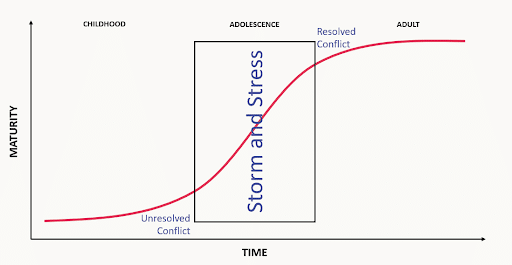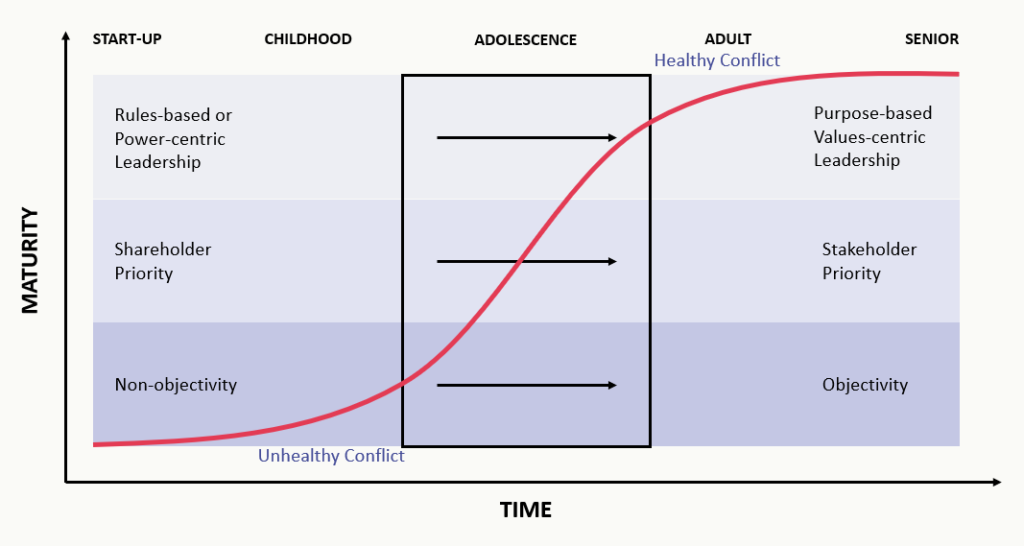To view the presentation slide show, click here
In this workshop, we discuss the transitions that constitute a company’s maturity – and how these transitions position a company to overcome crises. Andy Grove, the former CEO of Intel said: “Bad companies are destroyed by crises. Good companies survive them. Great companies are made better by them.” We analyze the differences between these outcomes and how the ability to resolve conflict through the process of maturity positions a company to ‘be made better’ when working through a crisis.
Adolescence
The nineteenth-century psychologist, G. Stanley Hall, developed the phrase “Storm and Stress” as a label for an individual’s adolescence. Regarded as the father of child psychology, Dr. Hall described this period as the most turbulent in an individual’s life. Its outcome is mainly dependent on conflict resolution – in his theory, it is the conflict between the child and the parent(s). The ability to be productive and functional as an adult depends on resolving this conflict during adolescence.

Companies or businesses also have a period of adolescence. And, like the individual in Dr. Hall’s model, their ability to be functional as mature businesses depends on conflict resolution during adolescence. In the case of business, it is the ability to convert unhealthy conflict to healthy conflict. The companies that achieve this conversion are positioned to be made better by crisis. Those that don’t are likely to be destroyed by it.

My company, over twenty-seven years, survived several crises. Two of the crises were existential. The company should not have survived either of them. Yet, it not only survived them – it was made better by them. The making better positioned the company for a magical run in its final years leading up to its acquisition. This experience, plus the conversations and advisory work I have continued to do with entrepreneurs and CEOs, reveal three transitions that constitute a company’s adolescence. Making these transitions enables conflict conversion – converting it from unhealthy to healthy. This conversion is the difference between being destroyed by crisis and being made better by it.
Unlike an individual’s adolescence, the adolescence of a business can occur at different places in its timeline. It can also happen over a long or short period. If unhealthy conflict is the trigger for adolescence, then companies with dynamic leadership or innovative products will have more runway and may enter their period of storm and stress later in their lifecycle. More commoditized companies will have a shorter runway and enter this period earlier. Companies with a strategic and proactive culture may incur adolescence over a more extended period. Companies with a tactical and reactive culture are more likely to realize their adolescence over a shorter period.
Transitions
The three transitions of adolescence are shifts from non-objectivity to objectivity, from shareholder to stakeholder, and from power-centric or rules-based leadership to purpose-centric and values-based leadership.
The literature advocating for one position or the other within each of these transitions is abundant. In this presentation, I suggest that the opposed positions of each of the transitions are not correct or incorrect. They are simply pre or post-adolescent. A young pre-adolescent business can benefit from non-objectivity, shareholderism, and power-centered or rules-based leadership. But these benefits become liabilities if we don’t transition out of them. This transition constitutes adolescence – the period of storm and stress. The ability to make the transitions amounts to the conversion of conflict. Conflict conversion enables our companies to be functional adults and to be made better when confronted with crisis.
Non-objective to Objective
Moving from non-objectivity to objectivity is the transition from working ‘in’ our companies to working ‘on’ our companies. Recognizing this transition’s importance was inspired by the work of Michael Gerber and his book ‘The E-myth,’ written in 1986. I suggest that in our pre-adolescence, there are benefits to relinquishing the commitment to the objectivity of working ‘on’ our businesses. These benefits include the technical expertise we bring to our companies, the capital contribution of our direct efforts, and the new knowledge we gain from – or the affinities we develop for front-line company positions. However, if we fail to transition away from these benefits through our adolescence, we lose the opportunities to be strategic, to recognize threats and opportunities, and to scale through the acquisition of talent. Moreover, without objectivity, we lose the ability to foster the additional transitions necessary for the conversion of conflict.

Shareholder to Stakeholder
Moving from a shareholder priority to a stakeholder priority is another necessary transition. When discussing this transition, I am careful to acknowledge the topic’s controversy. I distinguish between cultural stakeholderism and environmental stakeholderism – and that it is only cultural stakeholderism that I consider essential for adolescence. An immature, pre-adolescent status requires disproportionate focus on the shareholder, i.e., financial metrics, at the expense of stakeholder interests. However, to convert conflict, an organization must build trust between its team members. Building trust requires shifting away from the short-term, profit-first, zero-sum game prism of shareholderism and toward a long-term, purpose and people first, mutual benefit prism of cultural stakeholderism. In explaining this transition, I point out that the short view separates the shareholder from the stakeholder, but as the picture lengthens, the perspective increasingly becomes one and the same. Making this transition, we are replacing the short view with the long view – consistent with replacing immaturity with maturity.

In addition to distinguishing between cultural and environmental stakeholderism, I also differentiate between authentic and outcome-oriented stakeholderism. Authentic stakeholderism is motivated by empathy and manifests as compassion. In the adolescent stage of our maturity curve, it is authentic stakeholderism that we desire for the conversion of conflict.

Power-Centered to Values-Based
Moving from dynamic power-centered or rules-based leadership to purpose-centered and values-based leadership is perhaps the most intuitive of the three transitions for the conversion of conflict. As young, pre-adolescent businesses, we are dependent on dynamic leadership to foster functionality and prevent our companies from descending into chaos. In the absence of dynamic leadership, we often have robust and rigid hierarchies and rules constructs to do the same. Dynamic power-centered leadership is transient and unreliable over the long term. Unnecessary rules quash engagement and creativity. Maturity requires replacing our dependence on power-centered or rules-based leadership with purpose-centered and values-based leadership. Purpose-centered and values-based leadership is stable, durable, and fosters the conversion of conflict. We can look across the business landscape and see many high-profile companies that made this transition – most notably Apple.

Unhealthy and Healthy Conflict
The presentation concludes with definitions of unhealthy and healthy conflict. Defining conflict types helps the audience understand and recognize their differences. Unhealthy conflict manifests itself as a battle of egos, while for healthy conflict it is a battle of ideas. With unhealthy conflict there is an emergence of individualism whereby the individual subordinates the team to ego. When healthy conflict is present, there is an emergence of individuality. Here, the individual is subordinated to the team through anchoring to purpose within a framework of values. Understanding the difference between individualism and individuality is essential for understanding the difference between unhealthy and healthy conflict.
Unhealthy conflict fosters political culture and is burdened by employees who light fires (or allow fires to be lit) to gain self-importance. Conversely, healthy conflict results in organizations blessed with employees that prevent the fires from being lit. Finally, and most important, the conversion to healthy conflict in the adolescence of our companies fosters the collective determination, engagement, creativity, and organizational health that enables a company to be made better by crisis.

The presentation concludes with a salute to the audience for caring enough to engage and for their willingness to be changed by what they heard.

